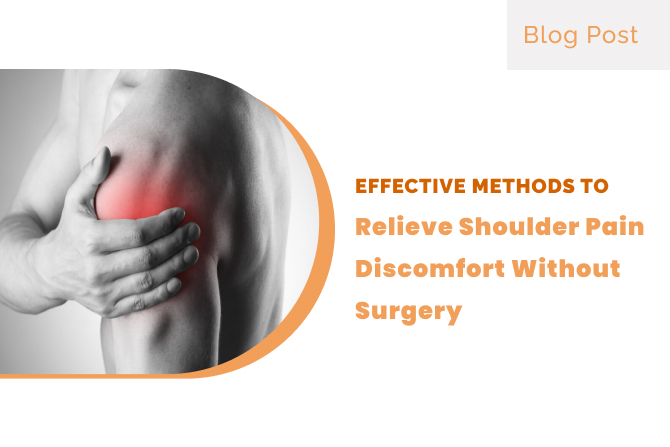Effective Methods to Relieve Shoulder Pain Discomfort without Surgery

Relieve Shoulder Pain Without Surgery
Introduction
Shoulder pain is a prevailing concern that afflicts a significant number of individuals worldwide. Its causes range from injuries and overuse to underlying medical conditions such as arthritis, resulting in distress that can impede the performance of daily tasks and hinder the enjoyment of life. While surgical intervention may appear to be the only alternative for severe cases, there exists a bunch of non-surgical approaches that effectively alleviate shoulder pain and enhance mobility. Within this blog article, let’s search into a diverse range of natural procedures and techniques, thoughtfully cluster to assist you in discovering relief from shoulder pain without alternative to surgical intervention.
Understanding Shoulder Pain
Before proceeding with exploring potential solutions, it is crucial to acquire a thorough understanding of the anatomy of the shoulder as well as the prevailing factors that contribute to pain. The shoulder, an elaborate amalgamation of bones, muscles, tendons, and ligaments, affords an extensive spectrum of motion. However, this complex nature renders it vulnerable to injury and overexertion. Several frequently encountered sources of shoulder pain are delineated below:
- Rotator cuff injuries: Tears or inflammation in the muscles and tendons surrounding the shoulder joint.
- Tendonitis: Inflammation of the tendons due to overuse or repetitive motions.
- Bursitis: Inflammation of the fluid-filled sacs (bursae) that cushion the shoulder joint.
- Frozen shoulder: Stiffness and pain in the shoulder joint due to thickening of the surrounding tissues.
- Arthritis: Degenerative changes in the shoulder joint, leading to pain, swelling, and stiffness.
Symptoms of Shoulder Pain
The symptoms associated with shoulder pain are contingent upon the underlying etiology, although prevalent indicators encompass:
- Discomfort experienced during motion or while at rest
- Restriction of movement or rigidity
- Inflammation or edema surrounding the joint of the shoulder
- Impaired strength or instability in the shoulder region
- Auditory sensations of clicking or popping during physical activity
- Challenges encountered in the performance of routine tasks, such as reaching or lifting objects
Non-Surgical Treatment Options
Fortunately, many cases of shoulder pain can be effectively managed without resorting to surgery. Here are some non-surgical treatment options to consider:
- Rest and Activity Modification: In the acute phase of shoulder pain, it’s essential to rest the affected shoulder and avoid activities that aggravate symptoms. Adjust your daily routine to minimize repetitive motions or heavy lifting that could further strain the shoulder joint.
- Physical Therapy: Physical therapy plays a crucial role in the rehabilitation of shoulder injuries. A qualified physical therapist can create a personalized exercise program to strengthen the muscles surrounding the shoulder, improve range of motion, and enhance stability. Therapeutic modalities such as ultrasound, electrical stimulation, and manual therapy techniques may also be used to alleviate pain and promote healing.
- Anti-Inflammatory Medications: Nonsteroidal anti-inflammatory drugs (NSAIDs) such as ibuprofen or naproxen can help reduce pain and inflammation associated with shoulder injuries or conditions like tendonitis or bursitis. However, long-term use of NSAIDs should be supervised by a healthcare professional due to potential side effects.
- Corticosteroid Injections: Corticosteroid injections can provide temporary relief from shoulder pain and inflammation by reducing swelling and suppressing the immune response. These injections are typically administered directly into the shoulder joint or surrounding tissues under ultrasound or fluoroscopic guidance.
- Platelet-Rich Plasma (PRP) Therapy: PRP therapy involves injecting a concentrated solution of platelets derived from the patient’s blood into the affected shoulder joint. Platelets contain growth factors that can promote tissue repair and regeneration, potentially accelerating the healing process in cases of tendon or ligament injuries.
- Regenerative Medicine: Emerging treatments such as stem cell therapy and prolotherapy offer promising options for addressing shoulder pain non-surgically. These techniques involve injecting biological substances or cells into the injured shoulder tissues to stimulate repair and regeneration.
- Modalities: Modalities such as cold therapy, heat therapy, ultrasound, and electrical stimulation can help alleviate shoulder pain and promote healing. These therapies may be used in conjunction with other treatment modalities as part of a comprehensive rehabilitation program.
- Activity Modification: Adjusting your daily activities to avoid movements or positions that exacerbate shoulder pain can help alleviate symptoms and prevent further injury. Avoid overhead reaching, heavy lifting, and repetitive motions that strain the shoulder joint.
- Ergonomic Modifications: Making ergonomic adjustments to your workspace, sports equipment, or household tools can help reduce strain on the shoulder joint and prevent overuse injuries. Ensure that your workstation is set up ergonomically, with proper chair support, desk height, and keyboard positioning.
- Lifestyle Modifications: Maintaining a healthy lifestyle can support shoulder health and overall well-being. Eat a balanced diet rich in anti-inflammatory foods, stay hydrated, get adequate rest, and engage in regular exercise to keep your shoulder joints flexible and strong.
Conclusion
Shoulder pain can significantly impact your daily life, but surgery isn’t always the only solution. By understanding the causes and symptoms of shoulder pain and exploring non-surgical treatment options, you can effectively manage your symptoms and promote healing without undergoing invasive procedures. However, it’s essential to consult with a healthcare professional to determine the most appropriate treatment plan for your specific condition. With patience, diligence, and a commitment to self-care, you can find relief from shoulder pain and restore function, allowing you to enjoy life to the fullest.Top of Form
